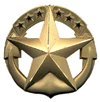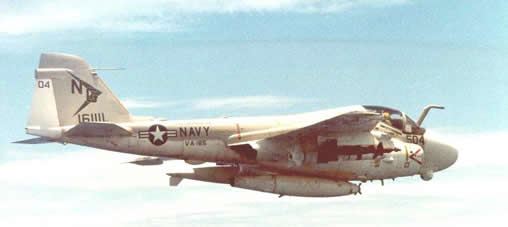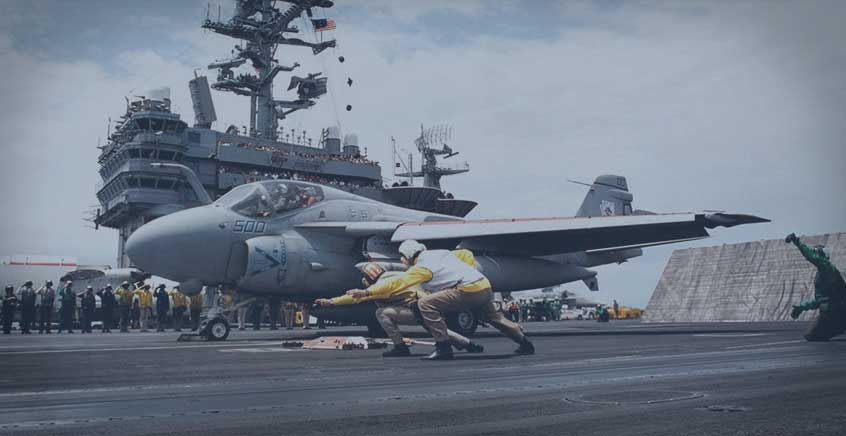VA-165 BOOMERS

The distinctive insignia worn by the Boomers consists of special elements and significant colors. The green boomerang is the focal point of the insignia, and signifies the squadron's ability to strike, and return and strike again. The gray background was selected to portray the all weather capability of the squadron and the aircraft. THe gold compass card, aligned to the four cardinal headings, is emblematic of the world wide commitments and global responsibilities of the Navy, which are supported by Attack Squadron 165. Central to the insignia is the white knight chessman denoting versatility and to indicate that the "Boomers, Have Weapons, Will Travel."
Command History
Attack Squadron ONE SIX FIVE (VA-165) was established on 1 September 1960. The Boomers initially flew the A-1 Skyraider, one of the most versatile aircraft in the fleet, and were based at NAS Alameda, CA.
Between 1960 and 1966 the squadron made four Western Pacific deployments aboard USS ORISKANY (CVA-34), USS CORAL SEA (CVA-43), and USS INTREPID (CVA-11). The Boomers were one of the first carrier-based attack squadrons to see combat action in Southeast Asia, flying over 3,100 combat sorties encompassing 11,500 flight hours, and expending 11 million pounds of ordnance of enemy targets during two combat deployments.
In January 1967, the Boomers moved to NAS Whidbey Island, WA, where they transitioned to the A-6A Intruder. The Boomers became the first West Coast operational A-6 squadron, and returned to Southeast Asia in November 1967 and again in 1968 as members of Carrier Air Wing TWO (CVW-2) aboard USS RANGER (CVA-61). While embarked on RANGER, the squadron received the COMNAVAIRPAC Battle "E", the Meritorious Unit Commendation, and the Navy Unit Commendation.
In February 1970, VA-165 joined CVW-9 aboard USS AMERICA (CVA-66), departing from Norfolk, VA for their fifth combat deployment to Southeast Asia. They completed 9,009 combat sorties and dropped 7.3 million pounds of ordnance. For their outstanding performance during the 1970 combat operations, the squadron was awarded their second consecutive COMNAVAIRPAC Battle "E". Between September 1971 and August 1973, the Boomers and CVW-9 completed two more combat deployments aboard USS CONSTELLATION (CVA-64). They flew 2,600 combat and combat support missions during this period, delivering a half-million pounds of bombs and transferring nearly 13 million pounds of jet fuel. For their superior performance, demonstrated courage, professional competence, and achievement of exceptionally impressive damage against heavily defended targets, the Boomers were awarded the nation's highest unit award, the Presidential Unit Citation. After nearly ten years of sustained combat operations involving six deployments, the Boomers returned to NAS Whidbey Island in October 1973 as the last squadron employed in the Southeast Asia conflict.
During the period from 1974 to 1980, VA-165 made three peacetime deployments with CVW-9 aboard USS CONSTELLATION (CVA-64), becoming the first A-6 squadron to conduct air operations in the Arabian Gulf. They were awarded two CNO safety awards, two consecutive COMNAVAIRPAC Battle "E" awards, the Meritorious Unit Commendation, and the CINCPACFLT Golden Anchor Award.
In 1981, VA-165 received the A-6E TRAM aircraft, and became the first carrier-based squadron to deploy with the Harpoon missile in the Indian Ocean. Returning to Whidbey Island, VA-165 was named COMMATVAQWINGPAC Intruder Squadron of the Year and Maintenance Squadron of the Year for 1981.
VA-165 joined CVW-9 aboard USS RANGER (CVA-61) in February 1983. Enroute to WESTPAC and the Indian Ocean in 1983-84, RANGER was tasked to show the American flag off the coast of Central America, a first for any A-6 squadron. Departing NAS Whidbey Island as the 1985 Intruder Bombing Derby Champions, Intruder Squadron of the Year, and Intruder Maintenance Squadron of the Year, the Boomers deployed in July with CVW-9 aboard USS KITTY HAWK (CV-63) and returned in December 1985 for a Christmas homecoming. During 1986, the Boomers proved once again they were the top Intruder squadron on the West Coast by receiving the Meritorious Unit Commendation, COMNAVAIRPAC Battle "E", CNO Safety "S", COMMATVAQWINGPAC Intruder Squadron of the Year, and the Norden Pickle Barrel Award for Bombing Excellence. The Boomers deployed in January 1987 aboard KITTY HAWK.
In July 1987, the Boomers completed their "Around the World" cruise, and were named the 1987 Intruder Squadron of the Year and Maintenance Squadron of the Year. Having returned from cruise only two weeks earlier, they also won the Norden Pickle Barrel Award for Bombing Excellence. During the training cycle the Boomers received their second consecutive COMNAVAIRPAC Battle "E", the Norden Pickle Barrel Award for Bombing Excellence, and were awarded the CNO's RADM Wade McClusky Award as the Best Attack Squadron in the Navy for 1987.
The Boomers deployed with CVW-9 aboard USS NIMITZ (CVN-68) in September 1988 to WESTPAC and the Indian Ocean, and received the Armed Forces Expeditionary Medal for operations in the North Arabian Sea and Gulf of Oman. They returned home in February 1989, only to be called to sea again in April for amphibious exercises off the Southern California coast, and in June for NORPAC 89-1 off the Alaskan coast. In July, the Boomers won the 18th annual COMMATVAQWINGPAC Intruder Bombing Derby and were named the 1989 Hughes Aircraft Corporation Intruder Squadron of the Year.
The fall of 1989 saw the Boomers filming inflight, flight deck, and hangar deck scenes for the Paramount Pictures Corporation motion picture, "Flight of The Intruder." In February 1990, the Boomers embarked with units from CVW-9 and CVW-1 aboard USS CONSTELLATION for her transit from San Diego, CA to Philadelphia, PA.
Following their South American transit, the Boomers began preparations for deployment with CVW-9 on USS NIMITZ. In June, the squadron received the Norden Pickle Barrel Award for Bombing Excellence, and embarked the following February aboard NIMITZ for a WESTPAC/Arabian Gulf deployment where the Boomers participated in post-hostility Desert Storm operations. In addition, numerous exercises were conducted with countries in the Gulf establishing new training opportunities for future deployments to the region. Upon returning home, the Boomers ended the year by winning the SECNAV Energy Conservation Award.
In February 1993, the Boomers again deployed aboard NIMITZ to the Indian Ocean and Arabian Gulf in support of Operation SOUTHERN WATCH. Returning home in August, the Boomers retire the final three KA-6D tanker aircraft in the Pacific Fleet, received the Pratt & Whitney Excellence in FOD Prevention Award, and were named the Hughes Intruder Squadron of the Year.
In 1994, the Boomers deployed to Nellis AFB, NV as part of Red Flag 94-2. In May, the squadron deployed to Roswell AFB, N.M. for Roving Sands '94, the largest joint air defense exercise conducted by the U.S. military anywhere in the world.
In the beginning of 1995 the Boomers started an arduous workup cycle in preparation for the squadron's upcoming deployment aboard NIMITZ. Starting in February, with carrier qualifications aboard KITTY HAWK, the squadron was a sea with the NIMITZ for five periods from February to September. During the spring of 1995, the squadron deployed with the rest of CVW-9 to NAS Fallon for integrated strike warfare training. Underway training was completed in October 1995.
On December 1, 1995, the Boomers deployed
onboard NIMITZ to WESTPAC and the Arabian Gulf. January 1996 found the
Boomers enforcing U.N. sanctions over Iraq completing
389 consecutive sorties. In March 1996, the Boomers and
NIMITZ took station off the coast of Taiwan in response to the China-Taiwan
election crisis before returning to NAS Whidbey Island for the last time
in May.

There have been a total of 32 Commanding Officers of The Boomers.
The first, CDR C. H. Yeagle served from 1960 to 1961. The last was CDR
M. S. Needler He served from 1995 until 1996.



